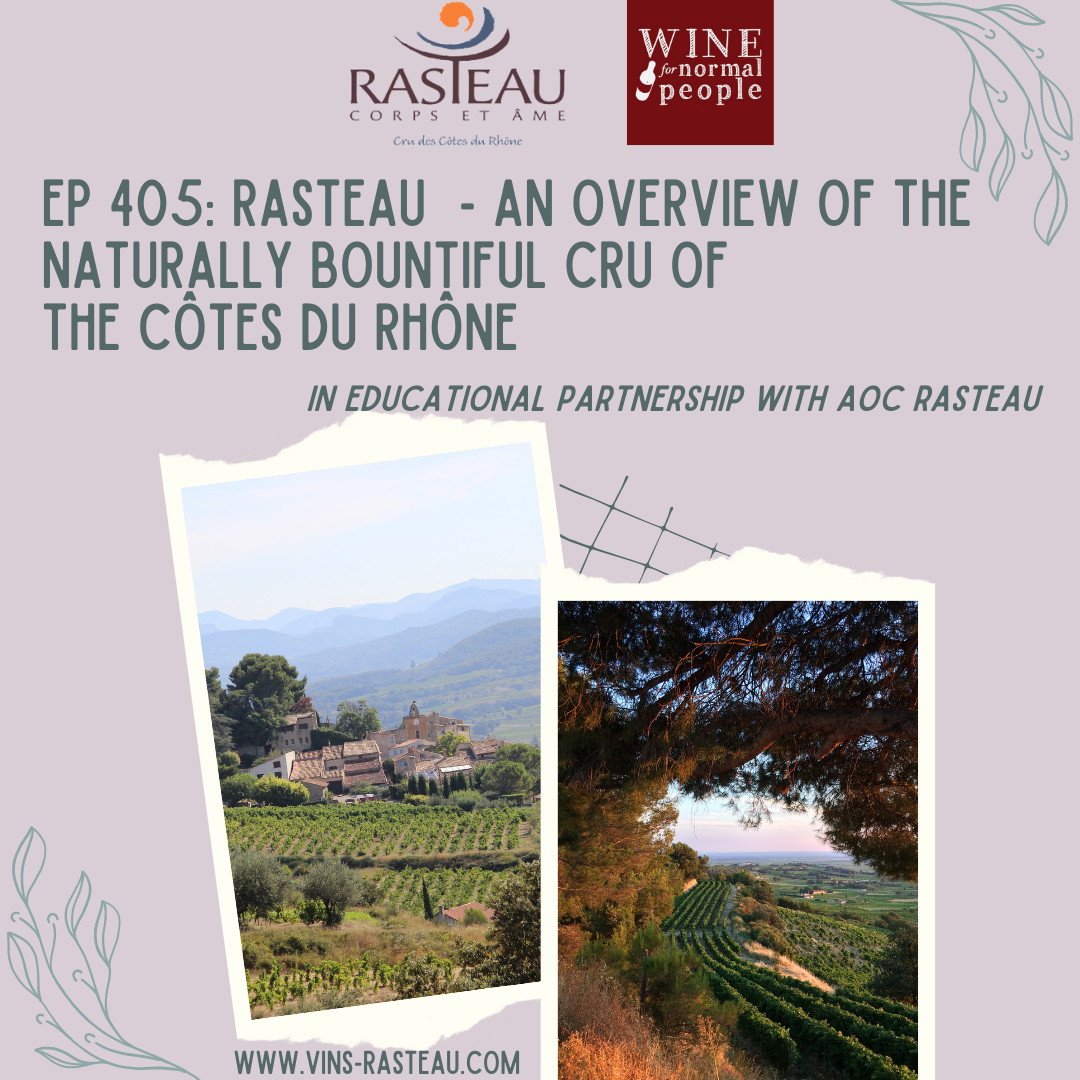Ep 405: Rasteau An Overview of the Naturally Bountiful Cru of the Cotes du Rhone

b'
Thank you to the region of Rasteau for the educational partnership and financial support for this show and for teaching us about this appellation, full of history, excellent wine, and passionate producers!
\\xa0
Rasteau, a Cru from the southern C\\xf4tes du Rh\\xf4ne vineyards, has a unique terroir. Its delicious wines are mainly dry reds made from Grenache, Syrah, and Mourv\\xe8dre, with a small production of the sweet vins\\xa0doux naturels. The cru is small with just 940 ha/2,323 acres making about 359,167 cases/yr, 4.31 mm bottles (in 2020). Around 60 producers form a very collegial community of passionate winemakers dedicated to the region.

The Rasteau terroir is varied, with a hot Mediterranean climate and low rainfall. Some parts of Rasteau experience the effects of the Mistral \\u2013 the strong, local, northern wind \\u2013 strongly, while others are sheltered from it.
\\xa0
The appellation is on a south-facing hill that faces the Dentelles de Montmirail, the limestone peaks that surround the southern appellations. The area has a diversity of soils \\u2013 with three distinct areas:
- A plateau, with elevations reaching 360 M/1181 ft. This area has sandy, stony soils, which retain heat well, storing it by day and releasing it to the vines at night.
- A mid-slope area between 160 m- 290 m/525 ft \\u2013 951 ft, the main area for vines with variable marl, sand, and clay soils, with some iron-rich and sandstone parcels. Syrah and Mourv\\xe8dre are best on sandy, clay, and marl soils, which have excellent water retention. Grenache thrives on the unique blue marl of this area.
- An area that slopes down to the south: the altitude 120-160 m/394 ft-525 ft, which is flatter and a bit warmer
\\xa0
Adhering to the stringent regulations imposed by the AOC, the Rasteau appellation produces dry red wines (96% of production) as well as the sweet vins doux naturels in red, ros\\xe9 and white (4%).\\xa0 The AOC ensures meticulous care and regulation of things like planting density, spacing, pruning, trellising, height of the canopy, and sorting. Certain clones of Grenache and Syrah are prohibited, as is irrigation. The minimum alcohol for dry wines is 12.5%, and Rasteau Cru must be aged until March 31st of the year after harvest.
The main grapes of Rasteau are Grenache, Syrah, and Mourv\\xe8dre. Red Rasteau is the main product and it must be at least 50% Grenache Noir, with a minimum of 20% Syrah and Mourv\\xe8dre together or separately. A maximum of 20% all the \\u201caccessory grapes\\u201d are allowed but whites can be no more than 10% of the mix.
Accessory grapes are: Carignan, Cinsault with Bourboulenc , Vaccar\\xe8se, Clairette (blanc and rose), Counoise, Muscardin, Piquepoul Noir, Terret Noir with whites:\\xa0 Grenache Blanc, Roussanne, Marsanne, Piquepoul blanc, Ugni blanc, Viognier, Grenache Gris
\\xa0
The style of Rasteau ranges from lighter and easy drinking to more serious and full-bodied. The common thread is that the wines are not over the top, they drink nicely when young, but can age in the right vintages. Flavors and aromas include garrigue (the famed herbs of this area \\u2013 thyme, rosemary, lavender), red berry, black cherry, black fruit, sometimes with leathery, dried fruit/jam, savory spice notes or, in bigger versions, cigar box, leather, earth, incense, and licorice. Generally the wines have fresh acidity and soft tannin. Bigger versions have sweet, juicy fruit sometimes with chewy tannins.
White and ros\\xe9 wines are made here but they are marketed as C\\xf4tes du Rh\\xf4ne-Villages or vins doux naturels.
\\xa0
The vins doux naturels are red, ros\\xe9, and white wines made from hand harvested Grenache Noir, Grenache Gris, and Grenache Blanc with any grapes that are allowed in the C\\xf4tes du Rh\\xf4ne, but accessory grapes can\\u2019t be more than 10% of the blend. Minimum alcohol must be at least 15% and the wines must age until August 31st of the year following that of harvest. The whites show floral and honeyed notes, the ros\\xe9s are like cherry brandy (kirsch) or jam, and the reds come in many styles from grenat, a tannic, fresh red to oxidatively aged ambr\\xe9, tuil\\xe9, and hors d\\u2019age (5+ years aging before release) and rancio (minimum 12 months aging in a barrel).
\\xa0
Food pairings include for Rasteau reds: stews, lentils, hard cheeses, grilled beef or eggplant/mushrooms, leg of lamb, charcuterie, blue cheese, or chocolate fondant.Rasteau vin doux naturel pairs well with a variety of sweet and savory foods.\\xa0The red is perfect with chocolate desserts,\\xa0the ros\\xe9 and ambr\\xe9 with Chinese sweet and sour dishes\\xa0and the white partners with herbed goat cheese.
\\xa0
These are excellent wines, and represent the passion of the producers whom we will hear from in a separate podcast. The wines represent exciting styles and are insane value for money \\u2013 grab a few bottles and try all this amazing region has to offer! You\\u2019ll never tire of drinking Rasteau.
\\xa0
Thank you again to the region of Rasteau for the educational partnership!
This podcast and post are part of a paid partnership. All photos courtesy of Rasteau AOC.
'



